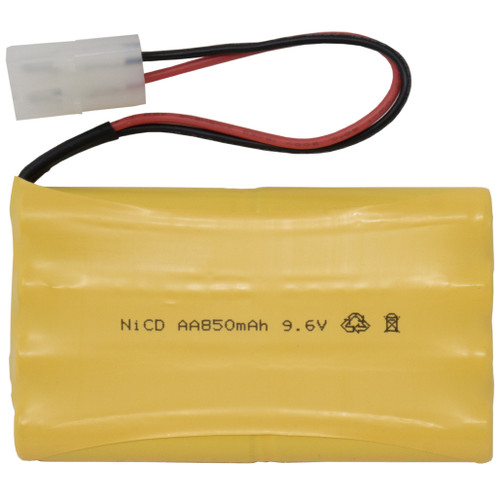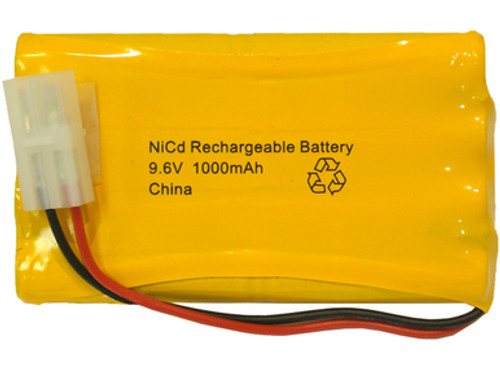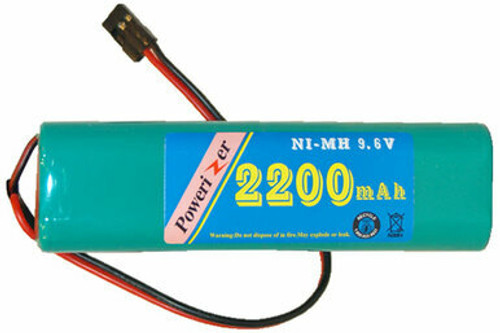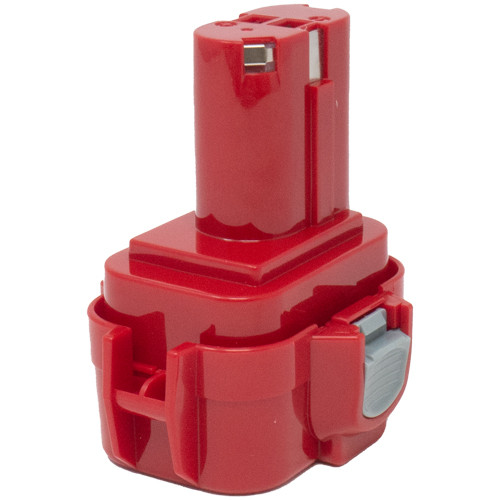
-

9.6 Volt AA NiCd Battery Pack (850 mAh) with Tamiya Connector
$19.69As low as:- Buy in bulk and save
Bulk discount rates
Below are the available bulk discount rates for each individual item when you purchase a certain amount
- Buy 2 - 3 and pay only $19.49 each
- Buy 4 - 12 and pay only $18.09 each
- Buy 13 - 25 and pay only $17.49 each
- Buy 26 or above and pay only $17.49 each
-

9.6 Volt AA NiCd Battery Pack (1000 mAh) with Tamiya Connector
$24.99As low as:- Buy in bulk and save
Bulk discount rates
Below are the available bulk discount rates for each individual item when you purchase a certain amount
- Buy 2 - 3 and pay only $24.99 each
- Buy 4 - 10 and pay only $23.19 each
- Buy 11 - 20 and pay only $22.49 each
- Buy 21 or above and pay only $22.49 each
-

9.6 Volt Square NiMH Battery Pack (2200 mAh) with HiTech Connector
$33.99As low as:- Buy in bulk and save
Bulk discount rates
Below are the available bulk discount rates for each individual item when you purchase a certain amount
- Buy 2 - 3 and pay only $33.99 each
- Buy 4 - 7 and pay only $31.59 each
- Buy 8 - 14 and pay only $30.59 each
- Buy 15 or above and pay only $30.59 each
-

-

-

-

-

-

-

9.6 Volt LiFePO4 Battery Pack with Leads (6400 mAh)
$129.99As low as:- Buy in bulk and save
Bulk discount rates
Below are the available bulk discount rates for each individual item when you purchase a certain amount
- Buy 2 - 5 and pay only $129.99 each
- Buy 6 - 7 and pay only $116.99 each
- Buy 8 or above and pay only $116.99 each
9.6 Volt Battery Packs: Rechargeable Power for Modern Devices
9.6 Volt battery packs, available in Nickel-Cadmium (NiCd) and Nickel-Metal Hydride (NiMH) chemistries, are a versatile and reliable power source for electronic devices. Their rechargeable nature, high capacity, and environmental benefits make them a popular choice over disposable batteries, particularly for devices with high power demands.
Understanding 9.6 Volt Battery Packs
A 9.6 Volt battery pack consists of multiple cells, typically eight, connected in series to deliver a combined nominal voltage of 9.6 volts. Both NiCd and NiMH packs are designed to provide consistent power for demanding applications and offer advantages over disposable batteries.
NiCd (Nickel-Cadmium) Battery Packs
Composition: Made from nickel and cadmium as the active materials.
History: One of the earliest rechargeable battery technologies, known for durability and high discharge rates.
Performance: Excels in high-drain applications, delivering consistent power over multiple cycles.
NiMH (Nickel-Metal Hydride) Battery Packs
Composition: Uses nickel oxide hydroxide and a hydrogen-absorbing alloy.
Environmental Impact: A more eco-friendly option than NiCd, as it does not contain cadmium.
Performance: Offers higher energy density, making it suitable for moderate- to high-drain applications.
Advantages of 9.6 Volt NiCd and NiMH Battery Packs
1. High Capacity
Both NiCd and NiMH battery packs provide significantly higher energy storage compared to disposable batteries of the same size. This makes them ideal for devices requiring extended runtimes, such as:
RC cars and boats
Power tools
Portable electronics
2. Long Cycle Life
Rechargeable 9.6 Volt battery packs can withstand hundreds of charge-discharge cycles before their capacity begins to diminish. This longevity makes them a cost-effective choice for frequently used devices.
3. Environmental Friendliness
Rechargeable batteries reduce the need for disposable batteries, which contributes to less waste in landfills. NiMH batteries, in particular, are a safer option for the environment as they do not contain cadmium, a toxic material found in NiCd batteries.
4. Versatility
9.6 Volt battery packs are widely used across various applications, from toys and hobbyist gadgets to professional tools and emergency equipment. Their versatility makes them a go-to choice for both casual and demanding users.
Limitations of 9.6 Volt NiCd and NiMH Battery Packs
While these battery packs offer significant benefits, they also come with some limitations:
1. Charging and Maintenance Requirements
Proper care is essential to ensure the long-term health of these batteries:
NiCd batteries must be fully discharged periodically to avoid the memory effect, which can reduce their capacity.
NiMH batteries do not suffer from the memory effect but may require regular recharging, as they tend to self-discharge faster than NiCd batteries.
2. Self-Discharge
NiMH batteries lose their charge more quickly than NiCd batteries when not in use. This makes them less ideal for infrequently used devices or long-term storage without periodic charging.
3. Sensitivity to Improper Use
Both NiCd and NiMH batteries require dedicated chargers to prevent overcharging, which can cause overheating and reduce their lifespan. Monitoring charge cycles and storage conditions is crucial for maintaining performance.
Applications of 9.6 Volt Battery Packs
1. Remote-Controlled (RC) Vehicles
RC cars, boats, and planes benefit from the consistent power output and high capacity of 9.6 Volt packs.
NiCd packs are often preferred for their ability to deliver high bursts of power, while NiMH packs provide extended runtime.
2. Power Tools
Cordless drills, saws, and other tools rely on 9.6 Volt battery packs for efficient operation.
NiCd packs excel in high-drain applications due to their robust performance under heavy loads.
3. Portable Electronics
Devices like portable speakers, lights, and radios use these battery packs for reliable, long-lasting power.
NiMH batteries are particularly suitable for electronics requiring higher capacity and longer runtime.
4. Toys
Battery-powered toys and hobbyist gadgets frequently utilize 9.6 Volt packs for their high energy density and rechargeability.
NiMH packs are often favored for their eco-friendly design.
Choosing Between NiCd and NiMH Battery Packs
When selecting a 9.6 Volt battery pack, consider the following factors:
1. Application Requirements
High-Drain Devices:
NiCd batteries are ideal for power tools and RC vehicles, delivering high current without significant capacity loss.
Moderate-Drain Devices:
NiMH batteries are better for portable electronics, toys, and applications requiring longer runtime.
2. Usage Frequency
Frequent Use:
NiCd batteries recharge quickly and handle frequent use well.
Infrequent Use:
NiMH batteries, despite their self-discharge rate, may still be a better choice for less frequent use due to their higher capacity.
3. Environmental Considerations
If reducing environmental impact is a priority, NiMH batteries are the better option as they do not contain cadmium.
4. Cost
While NiMH packs may have a higher upfront cost, their extended runtime and lack of memory effect can make them more economical in the long run.
Maintaining 9.6 Volt Battery Packs
To maximize the lifespan and performance of your battery pack, follow these best practices:
1. Use a Compatible Charger
Always use a charger designed for your specific battery type to prevent overcharging and overheating.
2. Store Properly
Store batteries in a cool, dry place, away from direct sunlight or extreme temperatures, to prevent degradation.
3. Discharge Appropriately
For NiCd batteries, fully discharge them periodically to avoid the memory effect.
NiMH batteries do not require full discharge, but periodic use helps maintain their health.
4. Recycle Responsibly
NiCd batteries must be recycled at designated facilities to prevent cadmium contamination.
NiMH batteries can also be recycled to recover valuable materials and reduce waste.
9.6 Volt NiCd and NiMH battery packs provide a dependable and eco-friendly power solution for a wide range of applications. Whether powering RC vehicles, tools, or portable electronics, these rechargeable batteries offer significant advantages over disposables in terms of capacity, cycle life, and environmental impact.
Choose NiCd packs for high-drain applications requiring quick recharging and robust performance.
Opt for NiMH packs for extended runtime, eco-friendliness, and moderate-drain applications.
By selecting the right battery pack and maintaining it properly, you can ensure reliable performance and long-lasting power for years to come. Investing in a quality 9.6 Volt battery pack is not just a practical choice—it’s a sustainable one.





